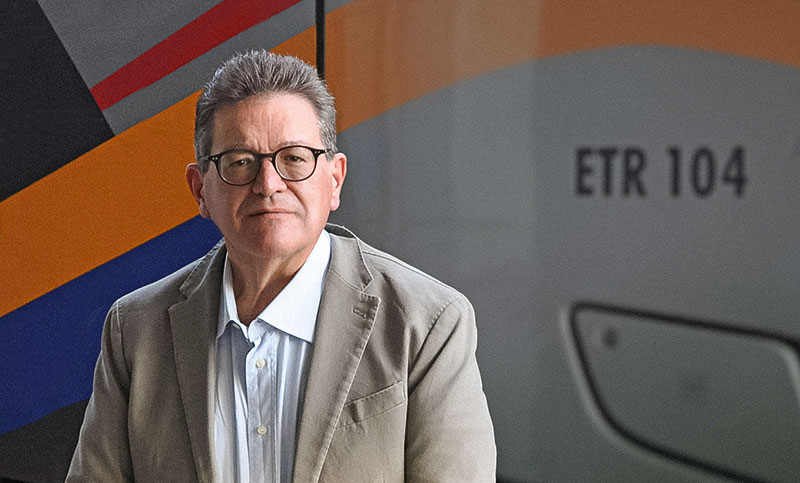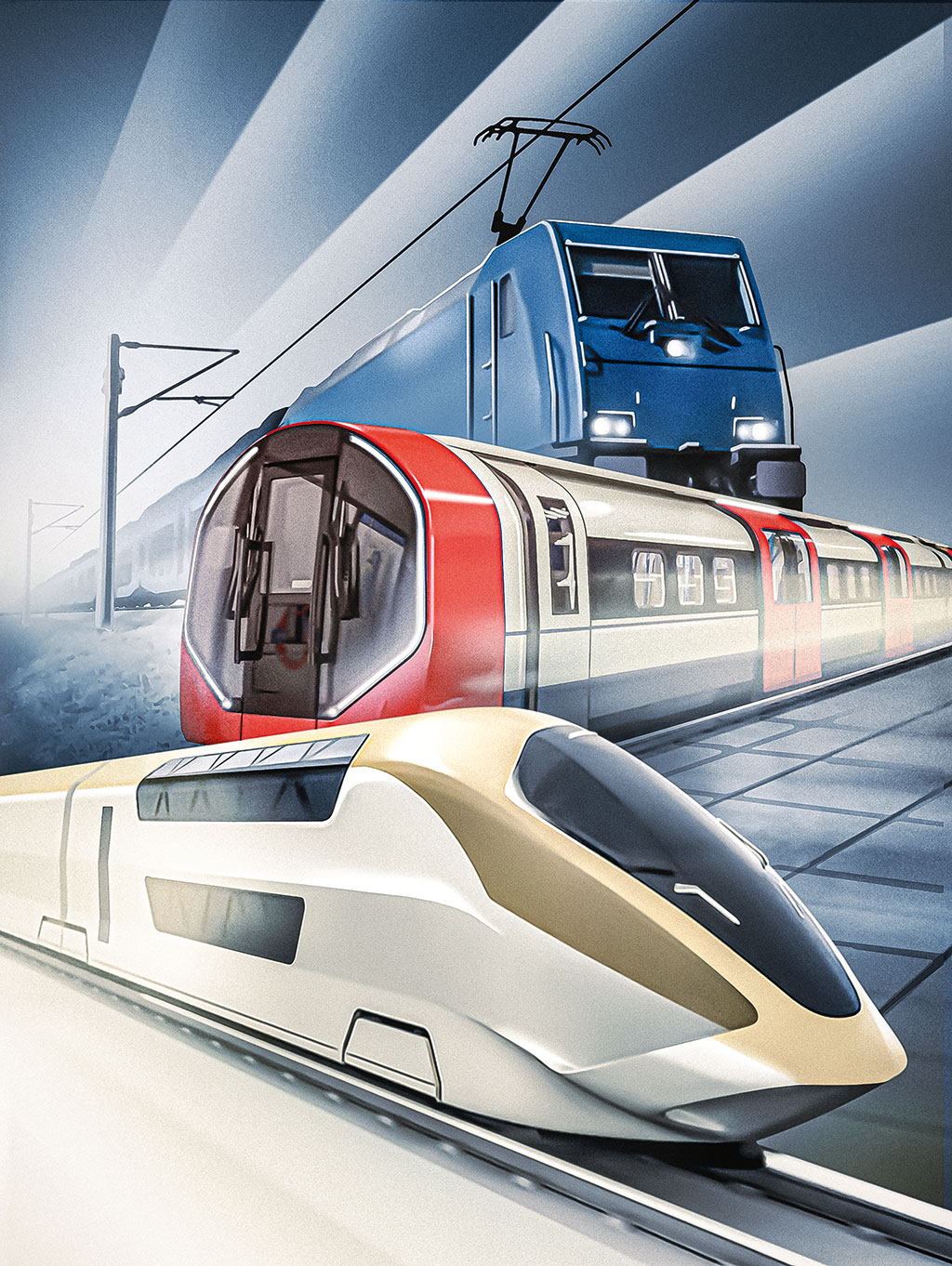Electrifying: Bringing electricity to millions of kilometers of rail. Equally electrifying: The resulting dynamics in drive concepts and traction transformers in, on, and under trains.
Globalization in recent decades has led to greater prosperity and innovations. Yet, it has also created new problems: Worldwide, the transport sector alone is responsible for about a quarter of all carbon emissions. One path to sustainable and fit-for-the-future mobility is through rail transport powered by green electricity. After all, in Germany alone, 74 percent of all train kilometers are already electrified.
Far less is discussed—at least publicly—about the locomotives, railcars, and drive concepts than about the rails. The question of how to convert electricity into motion as efficiently and reliably as possible is just as exciting —and one that transformer manufacturers and developers have been working on intensively for a long time.

Compact heroes
An electric drive in a moving object places special demands on technology. This is particularly the case for the transformers that convert current from overhead lines to drives. In addition, the performance of the transformers has an impact on the performance and safety of the entire train. In contrast to conventional transformers, they must be optimized for use in motion as well as in various air and temperature conditions and be particularly robust.
Just like with static transformers, a failure during operation results in significant costs and problems. If a malfunction occurs in the middle of nowhere, in the worst case it can take hours for a technician to arrive on site and start repairs. And then there’s the blocked track. A single malfunction can therefore quickly cause a cascade of additional problems and costs. This is true in the dense European network and even more so in less developed networks without parallel branch lines.
A transformer becomes small
The global market wants rail transformers that can be used flexibly, and components such as MR Traction Solutions that can be assembled just as flexibly so that they are compatible with the wide range of drives. When talking about trains, many people often think of “locomotives with electric drives inside”. But it’s not that simple.
The classic concept with a traction transformer in the locomotive’s main room is the dominant one for freight trains. Here it is important to be able to assemble trains from wagons and traction engines as desired. In passenger transport, modern trains now often form a unit consisting of the drive and wagons with the aim of making maximum use of the enclosed volume. Therefore, traction transformers are very often located on the roof, especially in local public transport. In contrast, in high-speed trains, they are often placed under the wagon. There, they optimize weight distribution at 250 or 300 kilometers per hour.

“In a primary substation, the size and weight of the transformer largely don’t matter. On the rail, we say: The lighter and smaller, the better.”Tullio Mantoan, Regional Sales Advisory
For all operations, however, every kilogram counts, and “less” is particularly important for modern passenger train concepts where not only speed matters, but also acceleration and deceleration, with the moving mass playing a huge role. The lighter the train, the less time it takes to brake into or accelerate out of a station. This reduces cycle times at stations, travel time from standstill to standstill, and of course energy consumption.
The second factor after weight is space. The space available in a freight locomotive is limited but compared to this, what modern commuter or high-speed trains demand of traction transformers is radical: “There is barely any space on the roof or between the wheels. In addition, air resistance and flow optimization in tunnels are key issues here,” says Tullio Mantoan, Regional Sales Advisory at MESCO Reinhausen. “That’s why it’s critical for both applications that the concrete design of the transformer models can be adapted to the individual train model. This is the only way rail designers can make ideal use of the available space.”
Mobile vs. stationary
Rail transformers also differ from their stationary relatives in their inner workings. Whereas power transformers can be single-phase or three-phase, railroad transformers are always single-phase shell or core transformers. In contrast to the 50 to 60 Hz of stationary transformers, they also operate at a frequency of less than 25 Hz with alternating current at an apparent power of about 1,000 to 2,500 kVA.
Some devices may also include inductors (reactors) for additional DC filtering, thus combining all magnetic components into a single housing. For cooling and insulation, they do not use mineral oils but rather ester- or silicone-based fluids that operate at temperatures of 100 to 150 degrees Celsius. They also often have the option of external cooling. Mantoan explains. “The practical reason is that these fluids are far less flammable and, at the same time, less coolant is needed. This also makes traction transformers pioneers in the use of alternative insulating fluids.” For the same reasons, they are also increasingly replacing their fossil predecessors in other applications.
Read more on this in the interview with Rainer Frotscher.
From the desert to the Arctic Circle
What else should a traction transformer be able to do? Fire, impact, and vibration resistance are obvious. But corrosion resistance is equally important, particularly for the models mounted underneath or on top of the train. And then there is the climate itself. Since most traction transformers are mounted on the outside of the locomotive, they operate under extreme conditions. Therefore, the transformer housing design is often created hand in hand with train manufacturers to optimally match the locomotive and its traction motors to the environment. To meet these high and varying requirements, Reinhausen Traction Solutions components are specially optimized for these conditions.


“Our components are optimized specifically for rail operations and can be easily mounted in various transformer housings.”
Tullio Mantoan, Regional Sales Advisory
Read more on this in “The moving transformer”
The green rail
Trains are more efficient than the equivalent truck or car convoys, even when pulled by diesel locomotives. This applies to energy consumption and carbon emissions, and also to tire wear and ground sealing. That is why shifting traffic to the rails is crucial in the medium and long term to achieve climate targets. But the really big potential of rail transport is the possibility of supplying clean drive energy directly to the drives on long routes without the need for a battery. Therefore, intensive efforts and major investments are being made on all continents to improve and expand the electric rail network.
The other side of the coin involves standardizing rails and railroads across national borders to build continent-wide, long-distance transport networks all over the world. In 2021, for example, the “Year of Rail,” this was the focus of the EU which, together with the Asian markets, is one of the biggest investors in the rail of tomorrow. Even today, much time is lost on long-distance trips in Europe because locomotives or even trains have to be changed at national borders. That is now supposed to change. For example, the Brenner Base Tunnel will lessen the strain on the road network across the Alps. “The goal is to transport passengers and goods in high-speed trains from Italy through Austria to Germany starting in 2030,” says Mantoan, who will benefit from the route himself if the Reinhausen locations in Italy and Germany are brought a little closer together.
Over countries and continents
The most ambitious project of this kind is the Chinese “One Belt, One Road” project, often called the “new Silk Road,” in which the expansion of intercontinental rail links plays a major role. African countries such as Uganda, Kenya, and Tanzania are working to rebuild old disused rail lines from the Colonial Era to create a Central and East African rail network. And a glance at the Americas demonstrates that huge investments are planned for expanding rail transportation there as well. All of this shows that even though the development toward climate-compatible global mobility is an enormous undertaking, the signal lights are green. The global market for traction transformers alone is expected to increase to a value of around 750 billion U.S. dollars, which is more than four percent growth since 2018 (Unife World Rail Market Study). And these expenditures are important to be able to meet the high demand to some extent. At the same time, the ongoing switch from fossil fuels to electric drives means an even higher demand for electricity. This is why everyone involved is joining forces to make all powertrain components even more economical, efficient, and lightweight.
Your Contact
 Do you have questions on transformer accessories?
Do you have questions on transformer accessories?
Tullio Mantoan is there for you:
Tu.Mantoan@reinhausen.com

